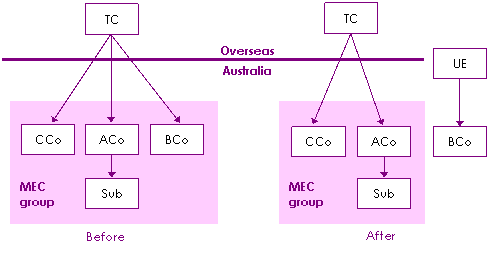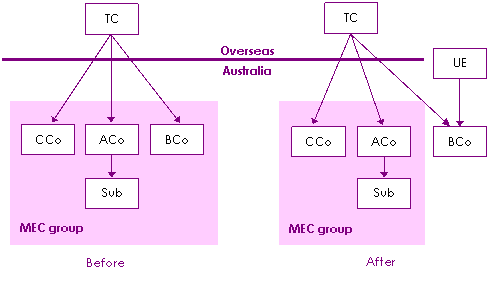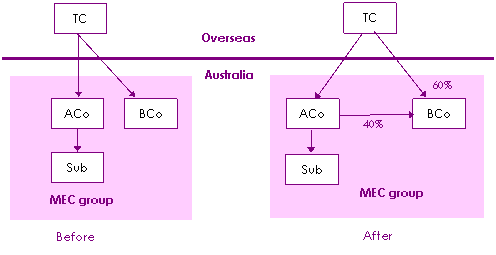Consolidation Reference Manual
You can still refer to the Consolidation reference manual for consolidation information that has not been impacted by changes in the legislation.
C10 MEC groups
C10-2 Worked example
Cost setting at leaving
C10-2-410 Events that trigger pooling in a MEC group
Description
This example explains how the cost setting amount (cost) for certain membership interests in an eligible tier-1 company held by an entity outside the multiple entry consolidated (MEC) group ('pooled' interests) is recalculated each time one or both of two 'trigger events' happen to the membership interest.
Broadly, these trigger events are:
- •
- an eligible tier-1 company leaves the group
- •
- a CGT event happens to one or more pooled interests in the company.
Commentary
A membership interest in an eligible tier-1 company held by an entity outside the MEC group is a pooled interest, provided it is not:
- •
- an employee share scheme interest, or
- •
- held only as a nominee for members of the MEC group.
Each time a pooled interest is affected by an event that triggers the pooling rules, the cost of all the pooled interests is recalculated (reset) using the pooling rules in Subdivision 719-K of the ITAA 1997, provided the market value of the pooled interests as a whole - including the market value of synergies arising from the combination of those interests - is more than nil just before the trigger time. The recalculation is made just before the trigger time using the formulas in that Subdivision.
For more details about how the pooling rules and formulas are applied: → 'Pooling of external membership interests', C10-2-420.
Events that trigger pooling
The cost of all the pooled interests in all of the eligible tier-1 companies in a MEC group is reset when:
- •
- an eligible tier-1 company leaves the group (trigger event 1), and/or
- •
- a CGT event happens in relation to one or more pooled interests in the company (trigger event 2),
providing the market value of the reset interests as a whole - including the market value of synergies arising from the combination of those interests - is more than nil just before trigger time.
The eligible tier-1 company affected by the trigger event is referred to as a trigger company. Not all the eligible tier-1 companies in a MEC group are necessarily trigger companies when a trigger event happens. However, both trigger companies and non-trigger companies have the cost of their pooled interests reset when a trigger event happens.
Where all the shares in an eligible tier-1 company are sold, both trigger events apply because there is a CGT event and the eligible tier-1 company leaves the group at the same time.
Example: Trigger event 1
An eligible tier-1 company ceases to be a member of the MEC group
Example 1
In figure 1, companies ACo, BCo and CCo (all eligible tier-1 companies) together with ACo's subsidiary form a MEC group. Later, top company (TC) sells all its shares in BCo to UE (an unrelated entity outside the group), so trigger event 1 happens. BCo ceases to be eligible to be a member of the group. The pooling calculation in Subdivision 719-K ensures that the pooled interests are given an appropriate cost by resetting the cost of the membership interests. The difference between the selling price and the cost of the reset interest (calculated using the pooling rules in Subdivision 719-K) is the capital (or revenue) gain or loss to TC.
Figure 1: An eligible tier-1 company leaves the group

It is also important to note that a company may leave the group and trigger the pooling provisions without a CGT event happening.
Events that are not CGT events that will trigger pooling include:
- •
- An eligible tier-1 company issues shares to entities outside the foreign wholly-owned group. The eligible tier-1 company ceases to be wholly-owned by the top company of the MEC group and leaves the group.
- •
- An eligible tier-1 company fails the membership eligibility rules after joining or formation time. In this instance the eligible tier-1 company ceases to be eligible to be a member of the MEC group.
Example 2
In figure 2, companies ACo, BCo and CCo (all eligible tier-1 companies) together with ACo's subsidiary form a MEC group. Later BCo issues some shares to unrelated entity UE. Trigger event 1 happens but there is no CGT event. BCo ceases to be eligible to be a member of the group. The pooling calculation in Subdivision 719-K ensures that the pooled interests are given an appropriate cost by resetting the cost of the membership interests.
Figure 2: An eligible tier-1 company leaves the group without a CGT event

Example: Trigger event 2
A CGT event happens to a pooled interest in an eligible tier-1 company without the eligible tier-1 company leaving the group
Example 1
In figure 3, companies ACo and BCo (both eligible tier-1 companies) together with ACo's subsidiary are members of a MEC group. The top company (TC) sells 40% of the membership interests in BCo to ACo but BCo continues to be a member of the MEC group. When the trigger event happens, a pooling calculation will ensure that the reset interests will have an appropriate cost just before the trigger event happens in relation to the membership interests in BCo. This reset cost is used to determine any capital (or revenue) gain or loss that TC makes on disposal of 40% of the membership interests in BCo.
Figure 3: CGT event

| Table 1: Examples of CGT events that will trigger pooling | |
|---|---|
| CGT event | Brief description |
| A1 section 104-5, ITTA 1997 | Disposal of a pooled interest |
| G1
section 104-135, ITTA 1997 |
A company makes a capital payment in relation to a pooled interest |
| G3
section 104-145, ITTA 1997 |
Liquidator declares the pooled interests worthless |
| I1
section 104-160, ITTA 1997 |
Australian residency ends |
References
Income Tax Assessment Act 1997, Subdivision 719-K; as amended by New Business Tax System (Consolidation and Other Measures) Act (No. 1) 2002 (No. 117 of 2002), Schedule 8
Income Tax Assessment Act 1997, Division 104
Income Tax Assessment Act 1997, Subdivision 719-T; as amended by New Business Tax System (Consolidation and Other Measures) Act 2003 (No. 16 of 2003)
History
Revision history
Section C10-2-410 first published (excluding drafts) 2 December 2002 and updated 28 May 2003.
Further revisions are described below.
| Date | Amendment | Reason |
|---|---|---|
| 26.10.05 | Extensive changes throughout. | For clarification. |
Proposed changes to consolidation
Proposed changes to consolidation announced by the Government are not incorporated into the Consolidation reference manual until they become law. In the interim, information about such changes can be viewed at:
- •
- http://assistant.treasurer.gov.au (Assistant Treasurer's press releases)
- •
- www.treasury.gov.au (Treasury papers on refinements to the consolidation regime).
Current at 26 October 2005
